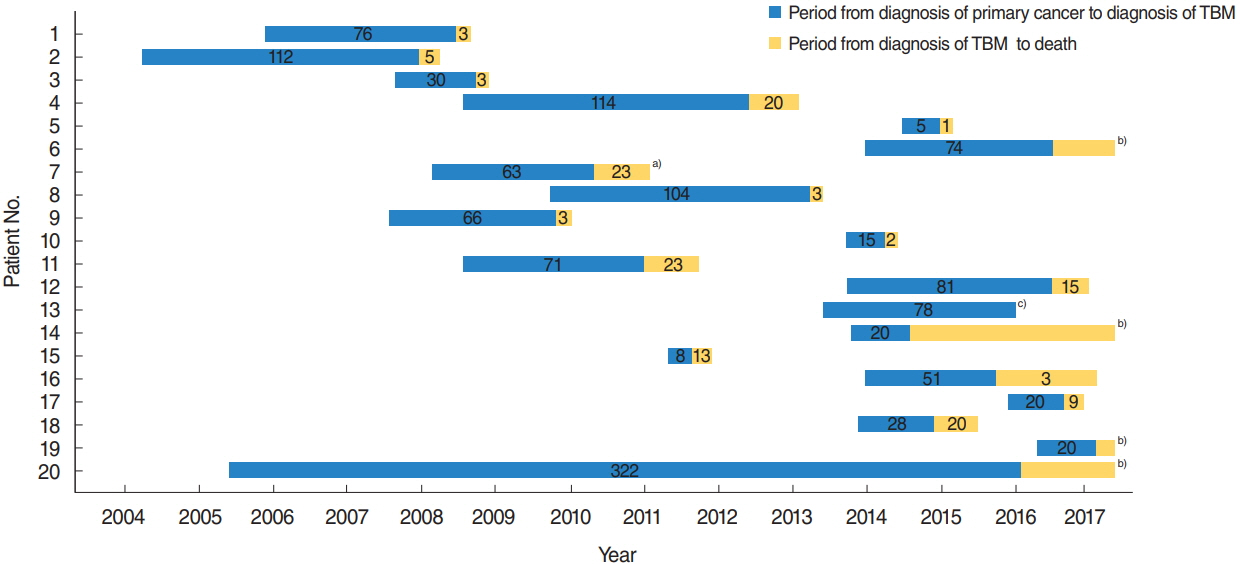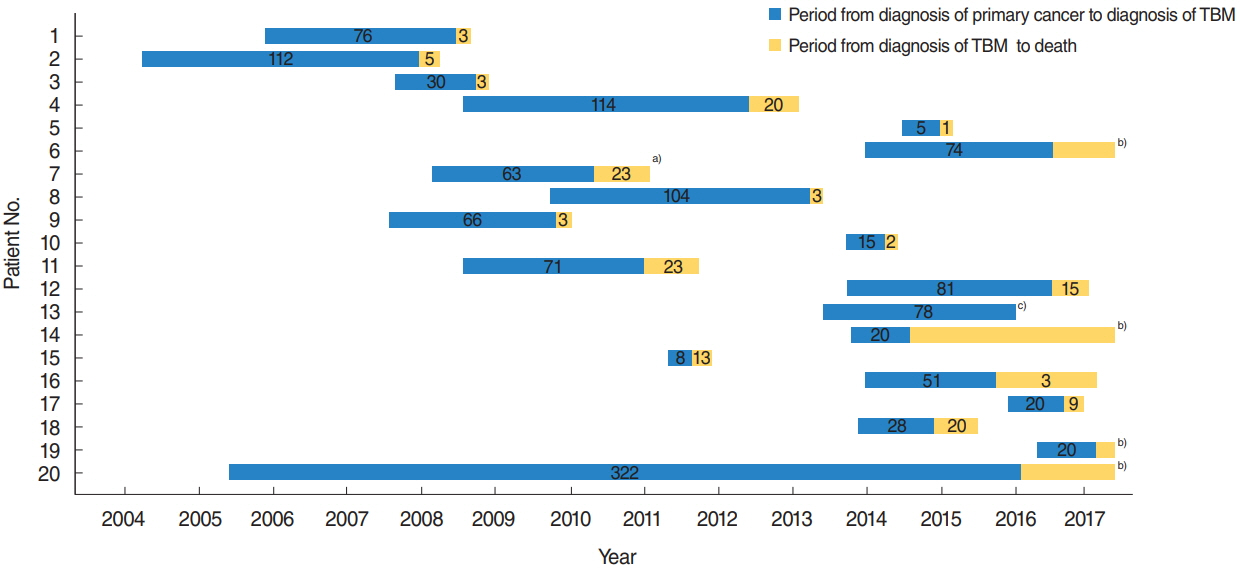Clin Exp Otorhinolaryngol.
2019 Feb;12(1):27-32. 10.21053/ceo.2018.00171.
Clinical Characteristics of Temporal Bone Metastases
- Affiliations
-
- 1Department of Otorhinolaryngology-Head and Neck Surgery, Chungnam National University Hospital, Chungnam National University College of Medicine, Daejeon, Korea. choijw@cnu.ac.kr
- 2Department of Internal Medicine, Chungnam National University Hospital, Chungnam National University College of Medicine, Daejeon, Korea.
- KMID: 2437488
- DOI: http://doi.org/10.21053/ceo.2018.00171
Abstract
OBJECTIVES
The purposes of this study were to evaluate the clinical characteristics of temporal bone metastasis (TBM) and to determine whether the characteristics differed according to primary malignancy.
METHODS
We retrospectively analyzed data on 20 patients diagnosed with TBM between January 2000 and January 2017. Demographics, the period from diagnosis of primary malignancy to TBM diagnosis, the period from TBM diagnosis to death, the type and staging of primary malignancy, otologic manifestations, and TBM sites were assessed. After the primary malignancies were divided into solid cancers and hematologic malignancies, each parameter was compared between the two groups.
RESULTS
The most common primary malignancy with TBM was lung cancer (45%). The most common otologic symptoms and signs were facial palsy (30.5%) and hearing loss (30.5%). The temporal squama (23%) and the facial nerve (20%) were the most commonly involved. Most TBMs occurred late in the disease process after the primary malignancy first metastasized to other organs. Hematologic malignancies metastasized significantly more frequently to the external auditory canal and the middle ear/mastoid compared to solid cancers (P=0.001 and P=0.004, respectively).
CONCLUSION
If otologic manifestations such as facial palsy and hearing loss are presented in patients at advanced stages of malignancy, TBM of primary malignancy should be suspected. In addition, hematologic malignancies tend to metastasize to the external auditory canal and the middle ear cleft more commonly than solid cancers do.
MeSH Terms
Figure
Reference
-
1. Streitmann MJ, Sismanis A. Metastatic carcinoma of the temporal bone. Am J Otol. 1996; Sep. 17(5):780–3.2. Jahn AF, Farkashidy J, Berman JM. Metastatic tumors in the temporal bone: a pathophysiologic study. J Otolaryngol. 1979; Feb. 8(1):85–95.3. Nelson EG, Hinojosa R. Histopathology of metastatic temporal bone tumors. Arch Otolaryngol Head Neck Surg. 1991; Feb. 117(2):189–93.
Article4. Belal A Jr. Metastatic tumours of the temporal bone: a histopathological report. J Laryngol Otol. 1985; Sep. 99(9):839–46.5. Aljafar HM, Alsuhibani SS, Alahmari MS, Alzahrani MA. Temporal bone metastasis as a sign of relapsing chronic lymphocytic leukemia. Saudi Med J. 2015; Oct. 36(10):1233–5.
Article6. Berlinger NT, Koutroupas S, Adams G, Maisel R. Patterns of involvement of the temporal bone in metastatic and systemic malignancy. Laryngoscope. 1980; Apr. 90(4):619–27.
Article7. De Vos C, Gerard JM, Decat M, Gersdorff M. Metastatic renal cell carcinoma to the temporal bone: case report. B-ENT. 2005; 1(1):43–6.8. Pontious MB, Kim SY, Backous DD. Metastasis to the petrous apex: a report of an uncommon case. Otolaryngol Head Neck Surg. 2003; Dec. 129(6):751–3.
Article9. Weiss MD, Kattah JC, Jones R, Manz HJ. Isolated facial nerve palsy from metastasis to the temporal bone: report of two cases and a review of the literature. Am J Clin Oncol. 1997; Feb. 20(1):19–23.10. Chang MT, Michaelides EM. High rate of bilaterality in internal auditory canal metastases. Am J Otolaryngol. 2015; Nov-Dec. 36(6):798–804.
Article11. Gloria-Cruz TI, Schachern PA, Paparella MM, Adams GL, Fulton SE. Metastases to temporal bones from primary nonsystemic malignant neoplasms. Arch Otolaryngol Head Neck Surg. 2000; Feb. 126(2):209–14.
Article12. Maddox HE 3rd. Metastatic tumors of the temporal bone. Ann Otol Rhinol Laryngol. 1967; Mar. 76(1):149–65.13. Sahin AA, Ro JY, Ordonez NG, Luna MA, Weber RS, Ayala AG. Temporal bone involvement by prostatic adenocarcinoma: report of two cases and review of the literature. Head Neck. 1991; Jul-Aug. 13(4):349–54.
Article14. Schuknecht HF, Allam AF, Murakami Y. Pathology of secondary malignant tumors of the temporal bone. Ann Otol Rhinol Laryngol. 1968; Feb. 77(1):5–22.15. Della Puppa A, Rossetto M, Berti F, Zustovich F, Manara R, Gardiman MP, et al. Internal auditory canal metastasis. J Neurosurg Sci. 2010; Dec. 54(4):159–62.16. Terao K, Cureoglu S, Schachern PA, Paparella MM, Morita N, Nomiya S, et al. Pathologic correlations of otologic symptoms in acute lymphocytic leukemia. Am J Otolaryngol. 2011; Jan-Feb. 32(1):13–8.
Article



